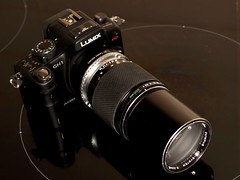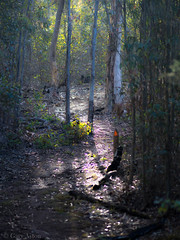Most portraits are lit by at least 2 light sources:
- a main or key light which is usually off-axis to the camera – for example 45 deg from the subject’s nose and above eye level, or directly in front of the subject’s nose and above eye level.
- and a fill-in light which ideally should not cast distracting shadows, and thus should either be a very broad light from behind the camera (eg. bounced flash off a wall), or on-axis flash such as a ring flash. Furthermore, we need to use ratio control so that the fill-in effect can be automatically adjusted to our liking.
For the purposes of this thought exercise, let’s say we would like to create some type of ring flash effect and have a remote TTL flash/speedlight/strobe as the main key light.
You could buy a camera manufacturer’s macro ring flash, but in general, they are expensive and have a small internal diameter restricting size of lenses which can be used. The Olympus ring flash does not allow remote TTL flash for a second flash and has limited lens compatibilities (an upgrade must be coming soon). The Canon ring flash does allow remote TTL flash but is not a complete ring and has adapters for 52mm, 58mm and 72mm filter threads. Nikon do not make a ring flash. If you already have a couple of speedlights, then a ring flash adapter for one of these may be an affordable option.
What if you do not wish to buy a true Ring flash but use a Ring Flash attachment to your flash?
The first ring flash attachment was the Ray Flash which clips onto your speedlight with your speedlight sitting in the camera hotshoe but unfortunately, this design precludes use of ratio TTL because the Ring Flash accessory obstructs the main flash infrared wireless TTL control system, and currently, there appears to be no version which would allow the accessory to fit a speedlight mounted on a FlexTT5 or MiniTT1 unit which is in the camera hotshoe – of course you could try hand holding it using an off-camera TTL cord but this Ring Flash accessory was not designed for ease of handholding. Furthermore, this design requires a different version for each camera-flash combination – see here.
The Orbis, a newer ring flash accessory looks to be more versatile as it should fit most camera-flash combinations (except older flashes such as Metz 45 series) and you can use ratio control TTL either by:
- infrared TTL from the flash – as long as you don’t cover it up with your hand, or
- RadioPopper PX attached to the flashes with off-camera TTL cord, or,
- off-camera TTL cord from a FlexTT5 or MiniTT1 sitting in the camera hotshoe
The main downside with the Orbis is the need to hand hold it (at least until they release their camera mounting kit later this year), but the great thing is that it will work with most brands including Canon, Nikon, Olympus, Sony, Pentax, Panasonic Micro Four Thirds, etc, and the internal diameter of the ring is 85mm (actual ~86-87mm) which means my version fits on my Olympus ZD 7-14mm super wide angle to get some unique creative shots.
So for combination of price and versatility, my vote currently goes to the Orbis and perhaps the Pocket Wizards as the remote TTL device – although if you can get adequate line of sight, infrared remote TTL may be adequate for your needs.
I shall be putting my order in – may be I will need to work out a way of not accidentally dropping either the Orbis or the flash as there is a significant risk if trying to juggle those two plus your camera and adjust settings and take the photo.
post-script:
bought the Orbis, but no wonder they seemed coy about the degree of light reduction – it seems you lose 5-6 stops!!
Testing it with a Canon 580EXII on full manual and on maximum zoom 105mm as recommended by Orbis, gives a flash meter reading at 2m and ISO 100 of f/2.5. Without the Orbis using same settings on the flash, gave me ~f/19. No wonder they recommend using ISO 400!
I will do more testing.










